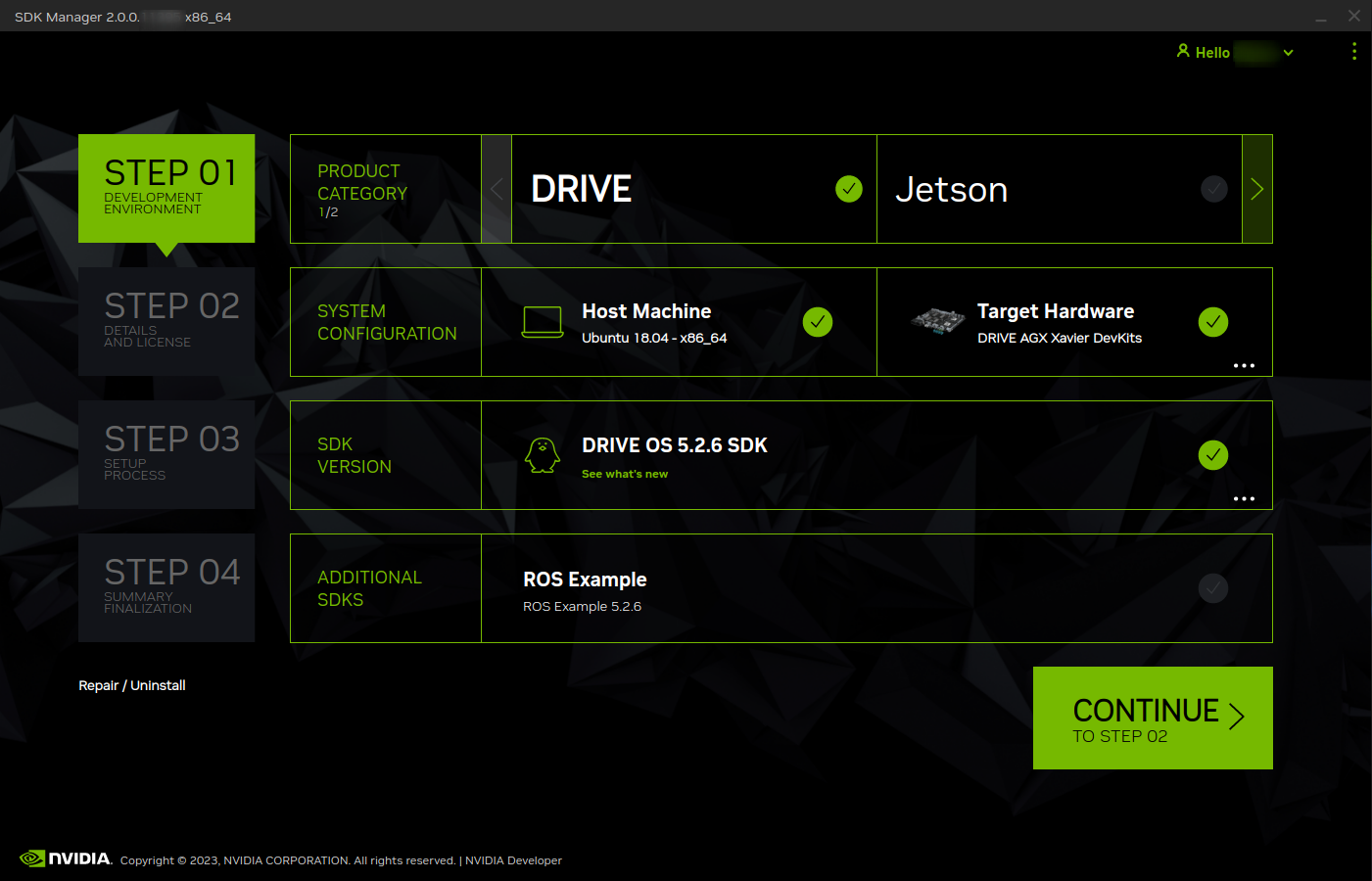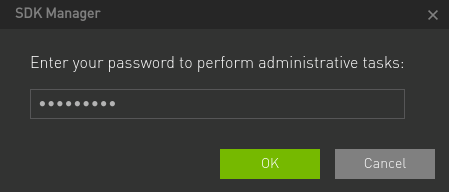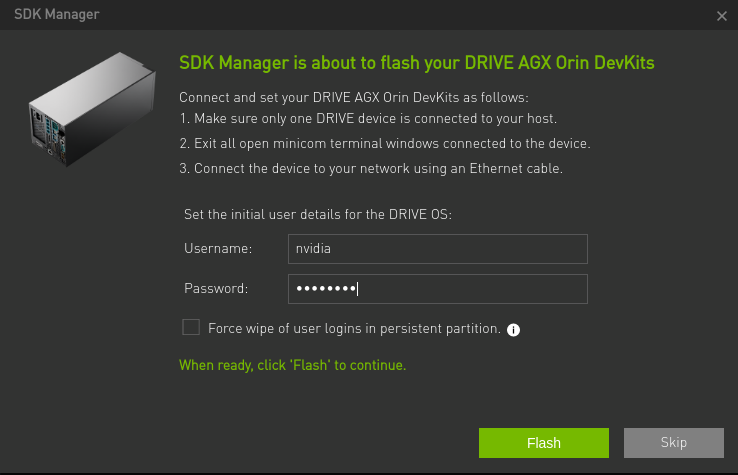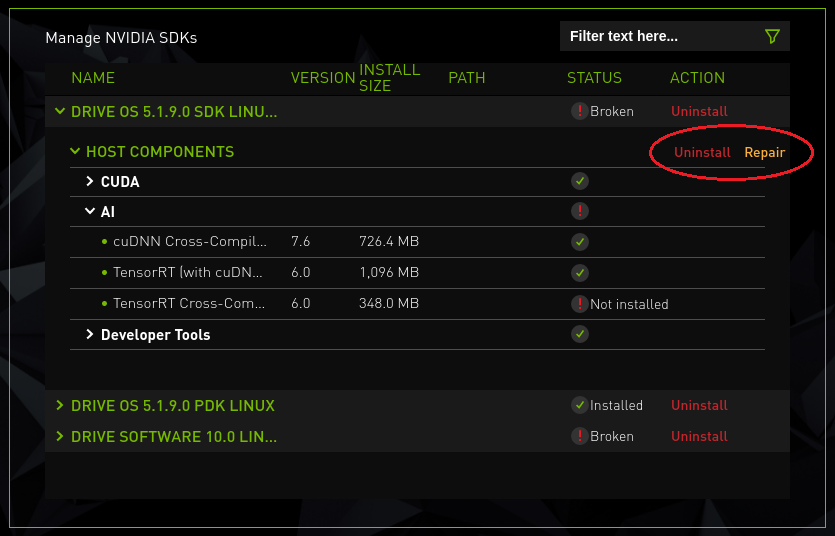Install DRIVE with SDK Manager#
This section is intended to help you use the NVIDIA SDK Manager GUI to configure your development environment successfully.
Note
SDK Manager no longer provides support for new DRIVE SDK releases. As a result, DRIVE SDK compatibility is limited to SDK Manager client release 2.2.0 or earlier.
STEP 01: Set Up the Development Environment#
From the STEP 01 Development Environment window, select the following:
From the Product Category panel, select the DRIVE development environment.
From the System Configuration panel, select the host machine and target hardware.
When a DRIVE target is connected, SDK Manager will auto-select DRIVE from the supported product category.
From the SDK Version panel, select the desired operating system, such as Linux or QNX. Notice that the target operating systems available can change, depending on the selected options in the other panels.
If relevant, select any Additional SDKs that you want to install.
An ellipsis (…) in the bottom right corner of a category box indicates that more than one option is available. Click on the ellipsis to show a drop-down menu of available options.

Note
Your display may differ from the one shown here. The information in this screen is populated from your NVIDIA user account access and permissions. If you don’t see your product category in the available selections, verify that your NVIDIA account is registered to the required programs.
Click Continue to proceed to the next step.
Note
If you are setting up a DRIVE OS QNX environment, you will see a pop-up where the path to the QNX toolchain should be entered before proceeding.
STEP 02: Review Components and Accept Licenses#
From STEP 02 Details and License, you can expand the host components and target components panels to review the components that will be installed on your system.
To review the licenses, click on the license agreements hyperlink at the bottom of the page.
Enable the checkbox to accept the terms and conditions of the license agreements.
If you want SDK Manager to download all setup files to a location other than the default path, go to the Download folder located at the bottom of the screen, then update the path you want to use.

For more information about the Download & Install folders, refer to Offline Install.
Select Continue to proceed to the next step.
STEP 03: Installation#
Before the installation begins, SDK Manager prompts you to enter your
sudopassword.
The display shows the progress of the download and installation of the software.

Select Pause / Resume to toggle the download and installation process.
At the top, you can toggle between the Details and Terminal tabs. The Terminal tab displays detailed information about the download and installation, with any errors highlighted.
On the Terminal tab, you can use the Filter text field to filter and search for specific information.
SDK Manager opens a dialog when it is ready to flash your target device. A prompt provides instructions for preparing your device to get it ready for flashing.
Note
The instructions in the flashing dialog vary based on your host and target environment settings.
Note
Pop-up Windows on the Linux Host During Target Flashing
When flashing the DRIVE AGX platform, different windows may pop up on the host. This can be seen on all DRIVE Software and DRIVE OS releases. These pop-up windows are harmless and do not affect flashing of the unit.

When flashing the DRIVE AGX Developer Kit, some data (e.g., user data, ssh keys, etc.) may be stored in a persistent partition that is not overwritten during flash. This allows you to keep your work data during re-flash. While this is default behavior, in some cases, you may need to wipe the persistent partition during flash. If so, enable the Force wipe of user logins in persistent partition option.
Note
We care about the safety and security of your data; therefore, SDK Manager prompts you to change your password before enabling the network on DRIVE AGX Systems.
SDK Manager will now complete the installation of the software libraries. Skipping this step will not install any SDK components on your target hardware, and will keep a clean operating system on your device.
STEP 04: Finalize Setup#
From STEP 04 Summary Finalization, there is a summary of the components that were installed, along with any warnings or errors that were encountered.
The Export Debug Logs link creates a ZIP file of all log files created during installation. This ZIP file is located in the same folder path where the SDK Manager installer downloaded all components.
Alternatively, click the menu icon in the top right corner of the window (”⋮”), and choose Export Debug Logs from the drop-down menu in the top-right corner.

Consult the Error Messages for information about any errors you may encounter.
Click Finish and Exit to complete the installation.
Repair and Uninstall#
To update or uninstall an SDK on your system, launch SDK Manager again.
On Step 1, under the installation step numbers, click the Repair/Uninstall hyperlink.

The Manage NVIDIA SDKs screen shows what has been installed on your system. You can select whether to repair a broken installation, update an existing SDK, or uninstall an SDK.

Recommended Recovery Steps#
There are many causes of various installation errors. Below is a checklist of common installation issues, which may help you recover from a broken installation.
Review the summary table to identify which component failed.
Expand the group with the “Error” status.
When you find the failed component, click the details icon to the right of Install Error to be redirected to the Terminal tab, which will display the exact error.

If the error is related to an environmental issue, such as a broken apt repository or missing prerequisite, try to fix it manually, then click the Retry Failed Items button.

Retrying the installation is also available in two other ways:
From STEP 01, use the Repair/Uninstall button to get to the Manage NVIDIA SDKs page. If needed, expand the SDK with the “Broken” status, then click Repair for the relevant part (Host or Target).

At STEP 01, select the required SDK and run through the installation again.
Finally, try to uninstall and reinstall the relevant SDK.